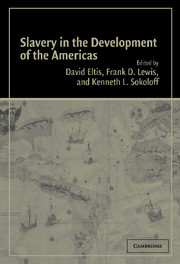Book contents
Introduction
Published online by Cambridge University Press: 18 August 2009
Summary
Between the fifteenth and the twentieth centuries, the center of gravity of global economic activity shifted from the Old World toward the New, and, within the Americas, from the tropical and sub-tropical to temperate areas. During most of this long durée – from the sixteenth to the nineteenth centuries – there evolved an intensive form of slavery supported by the largest mass migration of coerced labor in recorded history. At the center of both the growth process and the extensive coercion lay a relatively limited number of plantation regions that focused on the production and export of what was from the consumers' point of view a few luxury items: sugar, the various hard liquors that sugar made possible, coffee, and tobacco.
The plantation complex was characterized by expansiveness, flexibility, and innovation; and because plantations relied on both sub-tropical climates and slave labor, the growth nodes of the New World remained largely outside the temperate zones, at least until 1850. Moreover, before 1800, the countries in the temperate areas that came closest to matching the economic performance of the sub-tropical slave economies were the ones that traded intensively with them. These included the colonial powers of the Old World that controlled the extensive plantation areas of the Americas. By contrast, after 1800 – following abolition of the transatlantic traffic in slaves and the system of chattel slavery that it supported – rates of economic growth in the tropical areas lagged behind rates in the temperate zones.
- Type
- Chapter
- Information
- Slavery in the Development of the Americas , pp. 1 - 28Publisher: Cambridge University PressPrint publication year: 2004



